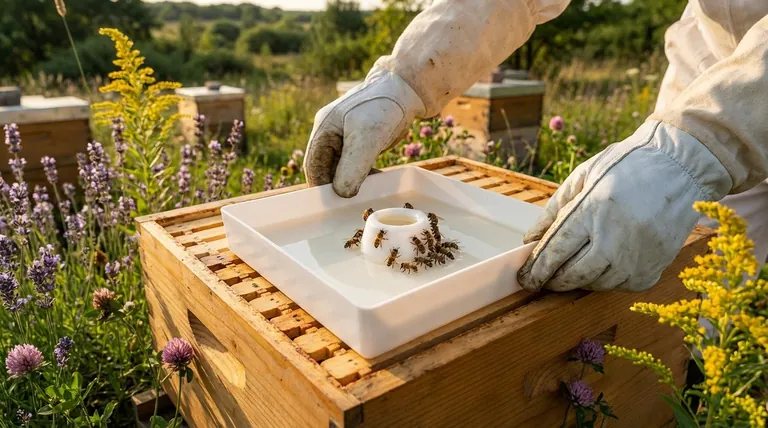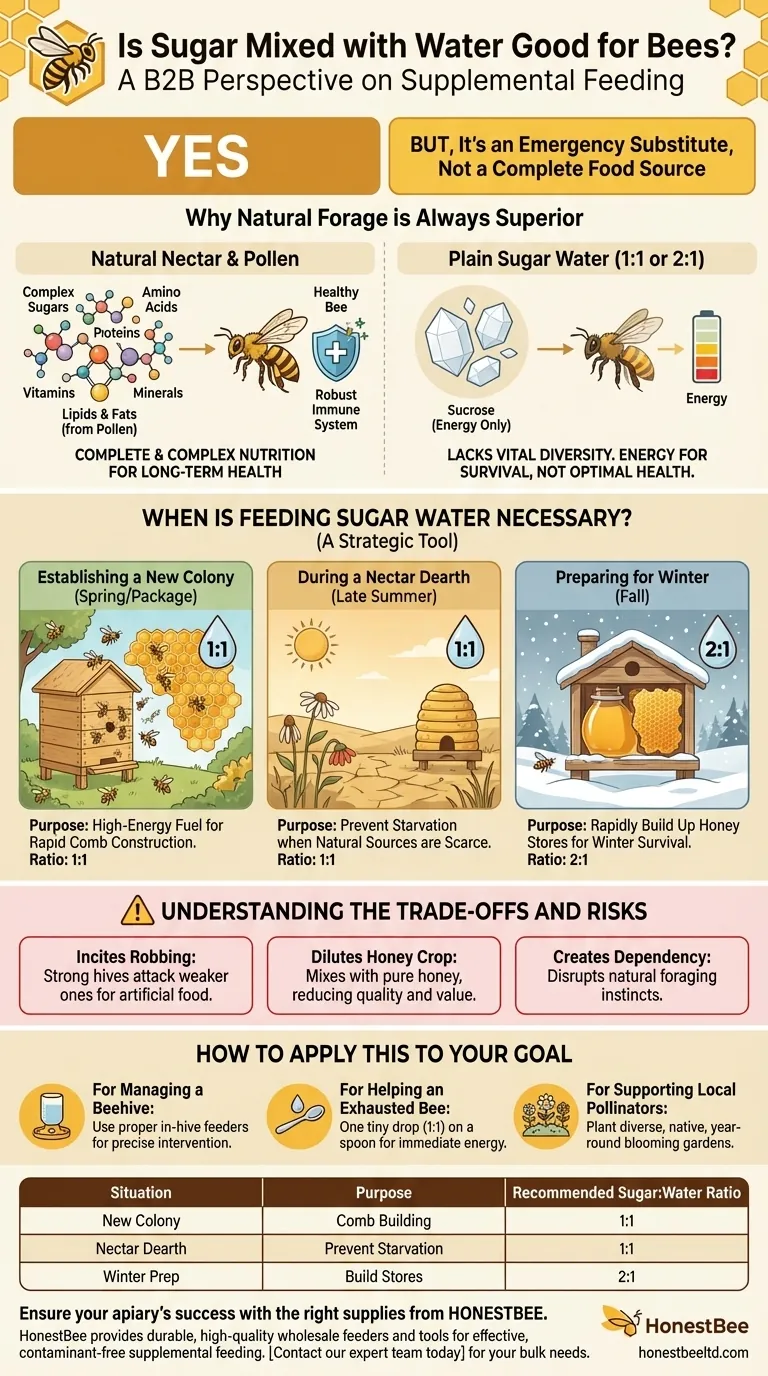Yes, in specific situations, sugar water can be a vital lifeline for honey bees. It serves as an emergency energy source when natural nectar is unavailable due to drought, cold weather, or a gap in the blooming season. However, it is a substitute, not a complete food source.
The critical distinction to understand is that sugar water is a carbohydrate supplement used to prevent starvation, while natural nectar and pollen provide the complete and complex nutrition bees require for long-term health and a robust immune system.

Why Natural Forage is Always Superior
The Nutritional Gap
Nectar is more than just sugar. It contains a complex blend of sugars, amino acids, proteins, vitamins, and minerals that bees have evolved to thrive on. These micronutrients are essential for everything from larval development to disease resistance.
Plain sugar water provides energy in the form of sucrose, but it lacks this vital nutritional diversity. It is the equivalent of a human living on soda and vitamin pills—you can survive, but you won't be healthy.
The Critical Role of Pollen
Bees get their fats, proteins, and lipids from pollen, not nectar. This is their primary food for raising young (brood). Feeding sugar water does nothing to address a pollen shortage, which is equally dangerous for a colony's survival.
When Is Feeding Sugar Water Necessary?
Providing sugar water is a key tool for responsible beekeepers, but it should be done with a clear purpose, not as a routine.
Establishing a New Colony
Newly installed bee packages or swarms have a monumental task: building an entire city of wax comb from scratch. A 1:1 sugar-to-water ratio provides the immediate, high-energy fuel they need to get this construction done quickly.
During a Nectar Dearth
A "dearth" is a period when no major nectar-producing flowers are in bloom. This often occurs in late summer. During a dearth, feeding can prevent a colony from consuming all its winter stores just to survive the present.
Preparing for Winter
In the fall, beekeepers may feed a heavier 2:1 sugar-to-water syrup. The goal is to help the bees rapidly build up their honey stores to ensure they have enough food to last through the long, cold winter months when they cannot forage.
Understanding the Trade-offs and Risks
While beneficial, feeding sugar water is not without potential downsides that must be managed carefully.
It Can Incite Robbing
An open feeder or spilled syrup can trigger a "robbing" frenzy. Stronger hives will find the artificial food source and may trace it back to a weaker hive, which they will then attack and rob of all its resources, often destroying it in the process.
Diluting the Honey Crop
If you feed sugar water while bees are also collecting nectar, they will store the syrup in the honeycomb. This dilutes the final honey product, disqualifying it as pure honey and reducing its nutritional value for the bees themselves.
Creating Dependency
Constant, unnecessary feeding can disrupt the natural foraging instincts of a colony. They may become reliant on the easy, artificial source and less motivated to seek out diverse natural nectar.
How to Apply This to Your Goal
Your approach should depend entirely on who you are and what you're trying to achieve.
- If your primary focus is managing a beehive: Use a proper in-hive feeder and feed sugar syrup only to establish a new colony, prevent starvation during a dearth, or build essential winter stores.
- If your primary focus is helping a single, exhausted bee: Offer a tiny drop of 1:1 sugar water on a spoon or leaf, just enough for it to regain the energy to fly away.
- If your primary focus is supporting local pollinators: The most impactful action is to plant a diverse garden with native, year-round blooming flowers, providing the natural forage bees truly need.
True support for bees comes from restoring their natural habitat, with targeted feeding used only as a precise and temporary intervention.
Summary Table:
| Situation | Purpose | Recommended Sugar:Water Ratio |
|---|---|---|
| Establishing a New Colony | Energy for comb building | 1:1 |
| During a Nectar Dearth | Prevent starvation | 1:1 |
| Preparing for Winter | Build winter food stores | 2:1 |
Ensure your apiary's success with the right supplies from HONESTBEE.
Feeding sugar water is a precise beekeeping task that requires reliable equipment. As a trusted wholesale supplier for commercial apiaries and distributors, HONESTBEE provides the durable, high-quality feeders and tools you need for effective supplemental feeding without the risks of robbing or contamination.
Let us help you manage your colonies with confidence. Contact our expert team today to discuss your wholesale beekeeping supply needs.
Visual Guide

Related Products
- HONESTBEE Professional Hive Top Bee Feeder Feeding Solution
- HONESTBEE Entrance Bee Feeder Professional Hive Nutrition Solution for Beekeeping
- HONESTBEE Round Hive Top Bee Feeder for Syrup
- Classic Boardman Entrance Bee Feeder Hive Front Feeding Solution
- HONESTBEE Professional Entrance Bee Feeder Hive Nutrition Solution
People Also Ask
- What safety features are included in top feeders? A Guide to Drowning Prevention and Hive Safety
- How do I keep bees from drowning in my top feeder? Ensure Safe Feeding for Your Hive
- What is the best way to top feed bees? A Safe, High-Volume Feeding Solution for Your Apiary
- What should be done with feeders and equipment after feeding bees? Essential Steps for Apiary Health
- Do I need an inner cover with a hive top feeder? Optimize Your Hive Setup for Healthy Bees



















